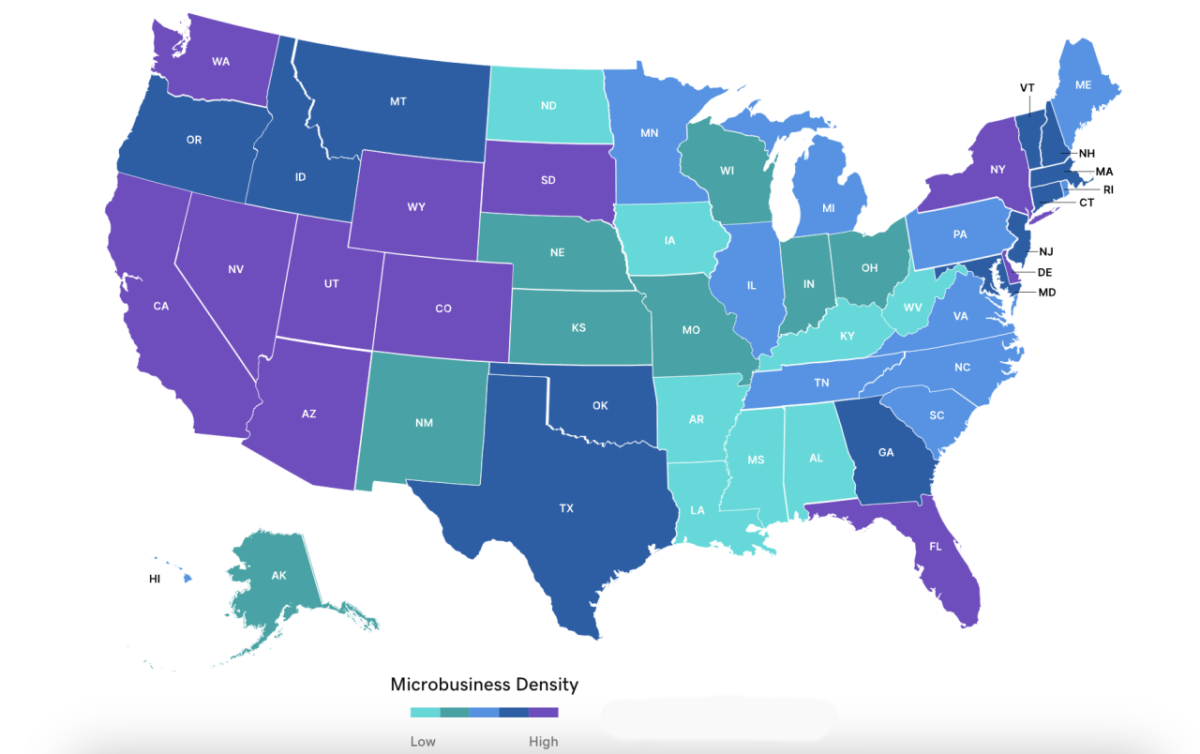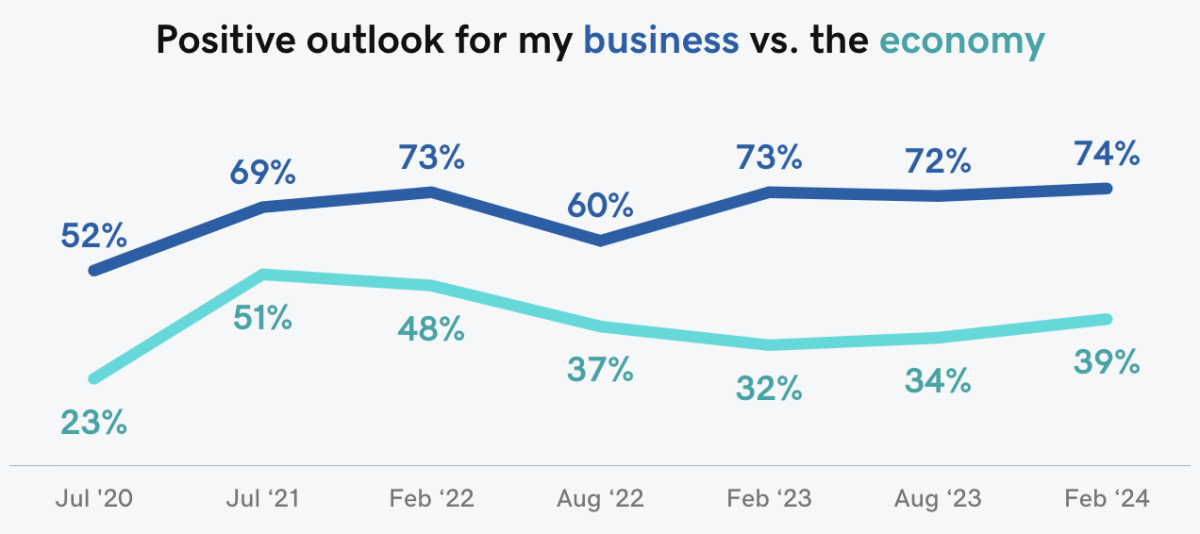2024 Uncovers A New Age For Global Online Entrepreneurs
GoDaddy Venture Forward: 2024 Annual Report
Originally published by GoDaddy’s Venture Forward Research Initiative
Small and microbusinesses boomed in 2024, expanding their reach and impact. Agile entrepreneurs harnessed cutting-edge tech to seize opportunities, fueling growth and innovation. These nimble ventures now fuel local economies. They create jobs and strengthen communities. Their resilience and adaptability are changing the business world. They are forging connections and shaping a new economy. This groundswell of entrepreneurial spirit promises a more vibrant, interconnected marketplace for all.
Below is an executive summary of key findings and excerpts from the GoDaddy Venture Forward annual report, including an interactive map with microbusiness data points over time on digital businesses with typically fewer than 10 employees. We invite you to explore and download the full report for extended insights and an exclusive dive into what’s happening with online entrepreneurs in 2024.Report Sections
Microbusinesses are growing
In 2024, microbusinesses are thriving from busy U.S. cities to remote U.K. communities. By adopting digital technology and AI, these small entrepreneurs surpass larger companies. Their hard work is driving post-pandemic recovery in Australia, Canada, the United Kingdom, and the United States. Innovative solutions and cutting-edge tools empower small players to set new industry standards. As markets evolve quickly, these agile firms lead the charge. Each bold move reshapes global commerce.
Ranking states by the growth in the number of their microbusinesses over the last year points to other interesting trends. While the largest states, known for their technology hubs, like New York, California, and Florida, show up in the top ten, a lot of movement and momentum is found in states of various sizes and around the country – from Delaware and Oklahoma to Washington.
|
Top 10 States By Microbusiness Count Growth1 |
||||
| State |
1 year Microbusiness Count % Growth |
5 year Count % Growth |
Active Microbusinesses July/Aug '24 |
Microbusiness July/Aug '24 |
| Delaware | 65% | 359% | 381,543 | 38.4 |
| Montana | 45% | 61% | 83,132 | 7.6 |
| Nevada | 36% | 44% | 601,058 | 19.4 |
| Washington | 31% | 50% | 720,836 | 9.4 |
| Colorado | 24% | 30% | 598,249 | 10.4 |
| New York | 21% | 29% | 1,832,298 | 9.2 |
| California | 14% | 19% | 4,026,197 | 10.2 |
| Florida | 14% | 32% | 2,471,412 | 11.4 |
| Oklahoma | 14% | 57% | 289,666 | 7.3 |
| Wyoming | 14% | 212% | 112,421 | 19.5 |
Every type of community saw double-digit growth in microbusiness growth over the last 5 years.
Microbusiness Density1
| Counties |
1 year Active Count % Growth |
5 year Active Count % Growth |
Microbusiness Density* July/Aug '24 |
% of all counties |
| Rural Less than 70 ppl. square mile |
8% | 24% | 2.7 | 63% |
| Suburban 70-250 ppl. / square mile |
7% | 19% | 3.5 | 22% |
| Urban More than 250 ppl. / square mile |
22% | 25% | 7.6 | 15% |
| *Microbusiness Density is defined as the number of microbusinesses per 100 people | ||||
Every year, the GoDaddy Venture Forward report shares annual changes in e-commerce activity in terms of revenue, number of orders, or number of sellers by industry, as self-reported by the website owner. These insights underscore interesting trends, such as the peak of wedding-related services post-pandemic, and then a continual decrease since then.
Year-Over-Year Average Revenue Change by Industry2
(Q3 2023 - Q3 2024)
| Top 5 Industries (by % Gain) | Bottom 5 Industries (by % Loss) | ||
| Industry | Y/Y Change | Industry | Y/Y Change |
| Financial | 142% | Writing | -77% |
| Marketing | 42% | Personal Services | -50% |
| Software/IT | 29% | Business | -50% |
| Religion | 24% | Food and Drink | -45% |
| Home Services | 14% | Wedding | -23% |
Microbusinesses make major economic impact
In 2021, we first revealed the outsized economic impact made by microbusinesses.
Together with economists and academic researchers, we uncovered that they drove up jobs and annual household median incomes, and drove down unemployment. Specifically, the job impact has grown from two or more jobs created for every microbusiness in 2020, to over seven jobs for every microbusiness entrepreneur on a county-level.
- 7+: Over seven new jobs are created by each microbusiness entrepreneur on a county-evel. In 2021, each microubusiness created just over two jobs.3
Key Entrepreneur Insights
Since 2019, GoDaddy Venture Forward has surveyed over 50,000 microbusiness owners with a GoDaddy domain and active website. Across Australia, Canada, U.K. and the U.S., most of these businesses have fewer than 10 employees, with a large portion being solo entrepreneurs. Despite their size, they are agile and resilient, consistently adopting digital solutions to adapt to changing economic conditions.
Microbusinesses are thriving, fueled by a blend of resilience and the innovative power of AI. Despite economic fluctuations, entrepreneurs remain optimistic about their ventures, betting on their ability to adapt and succeed in any climate. Regions like the South and Midwest in the U.S. exemplify this growth, with many microbusinesses planning to expand their teams in the coming year. This trend highlights not only the growth potential of digital microbusinesses but also how AI tools empower these small enterprises to innovate, scale, and thrive, even in a challenging economic environment.
- The South and Midwest are the most likely to hire additional employees over the next 12 months (28%), while the West is the least likely (20%).4
- 1 out of 4 business owners with a negative outlook on the national economy still plan to hire employees in the next 12 months.4
- Plans to hire by U.S. region align with the growth demonstrated in microbusinesses over the last year.4
Entrepreneurs in the microbusiness sector are driven by a diverse range of motivations—from the desire for autonomy and flexibility to a passion for their hobbies and causes. Digital entrepreneurship enables them to not only make a living but also create a fulfilling life. Their ambitions vary widely: while over one-third prefer to remain solo, one in five aspire to scale their businesses to mid- or enterprise-sized operations. Remarkably, nearly three-quarters of these entrepreneurs are already generating income, with many identifying as serial entrepreneurs; one in three currently manages multiple businesses. This dynamic landscape showcases the resourcefulness and adaptability of microbusinesses, empowered by technology and AI, as they navigate and flourish in today’s economy.
1. Microbusinesses are small4
- 93% of microbusinesses have fewer than10 employees
- 55% are solo entrepreneurs
- 45% have employees
2. Microbusinesses generate income4
- 31% Main
- 40% Supplemental
- 29% No Income
3. About 1 in 3 currently own more than one business4
Microbusinesses also have the power to close economic and gender gaps. In the last 5 years, women-owned microbusinesses have grown 10% to now being over half of all surveyed entrepreneurs. Almost one-third are the breadwinners contributing more than 51% of their household income, and Black women continue to be the fastest growing demographic of microbusiness owners.
- 51% Women-Owned; +10% since August 20194
- About 3 out of 10 women with a microbusiness are the breadwinners in their home. (Breadwinners contribute 51% or more of their household income).4
- 13% of U.S. microbusinesses are owned by a Black entrepreneur, and of those, 73% are owned by a Black woman.4
Microbusinesses are showing resilience and optimism. They are growing by adapting to AI technologies in a tough economy. These entrepreneurs face challenges. But, they are not just surviving; they are thriving. They have an unshakeable belief in their ability to shape their futures.
Four in ten business owners who didn’t sell their previous venture at a profit currently support their households. This shows their immense pressure and high stakes. For them, success is vital for family well-being. This need drives their pursuit of growth.
Microbusiness owners are increasingly turning to AI, with more than half now comfortable using it in their operations. This technological shift reflects a broader trend of adaptation and innovation. For 36% of GenAI adopters for their business, the payoff is tangible: increased revenue. AI tools help small businesses work faster, be more efficient, and stay competitive. As challenges grow, tiny businesses tap into AI’s power. This shows that adapting to change brings real benefits in today’s fast-moving market.
AI integration goes beyond a growth strategy – it’s a lifeline for entrepreneurs who refuse to give up. Driven by optimism, they’re using technology to overcome obstacles and build sustainable businesses. By adopting these advancements, microbusinesses are starting a new era of entrepreneurship. This era is defined by innovation, adaptability, and a drive for success for themselves and their families.
- 4 out of 10 current business owners who previously didn't sell at a profit are still the breadwinners of their households.4
How confident are you as a user of GenAl for your business?4
- 55%: CONFIDENT
- 31%: NEUTRAL
- 17%: NOT CONFIDENT
Over the last six months, how has your business' average monthly revenue changed?4
My revenue increased:
- 28%: Not Used GenAl
- 36%: Used GenAl
My revenue decreased:
- 29%: Not Used GenAl
- 24%: Used GenAl
About GoDaddy Venture Forward
A research initiative launched in 2018 that quantifies the growth and economic impact of over 20 million global online microbusinesses, and provides a unique view into the attitudes, demographics, and needs of these entrepreneurs.
Want More Country-Specific Microbusiness Insights?
Select below to see localized research data, entrepreneur stories and reports on microbusinesses.
1Source: GoDaddy Venture Forward 2019-2024
2Source: GoDaddy Venture Forward 2024
3Source: GoDaddy Venture Forward and U.S. Census
4Source: GoDaddy Venture Forward U.S. National Survey. February 2024 (N-U.S.= 3,565)




